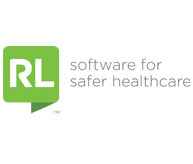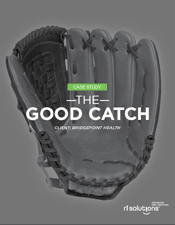Resource:
The Good Catch: Bridgepoint Health
Read how Bridgeport Health's customized good catch form increased their reporting by almost 400%.
THE CHALLENGE: Low good catch reporting means missed opportunities for safety improvements
At Bridgepoint Health, staff traditionally recorded good catches as near misses or zeros on the severity scale—if they were recorded at all. Management believed that by focusing on improving and increasing good catch reporting, they would be able to pinpoint areas that were at higher risk for incidents. From there, they could develop strategies to prevent those incidents from occurring in the future.
Bridgepoint uses the World Health Organization’s definition for a good catch, identifying it as an incident that did not reach the patient or a reportable circumstance (i.e., a situation in which there was a significant potential for harm, but no incident occurred). To improve good catch reporting, Bridgepoint’s patient safety team identified three goals they wanted to achieve:
- Foster an environment where staff understands the importance of reporting good catches.
- Develop a new method for reporting good catches that is accessible and easy to use.
- Improve the dissemination and use of the information to drive quality improvement.
To accomplish these goals, Bridgepoint’s patient safety team customized a form in its incident reporting software, RL6:Risk, to capture good catches.
THE SOLUTION: Customized reporting form surfaces hidden good catches
In an effort to improve its reporting, Bridgepoint’s patient safety team took good catches out of regular reporting and created a customized form in RL6 to capture them. This resulted in staff having an easier, more efficient way to report the data they observed.
The form was created through consultations with a group of inter-professional staff. The group analyzed what fields weren’t consistently used in the old forms in an effort to understand what information was not valuable. They also determined the minimum data required to support quality improvement and risk management functions. The resulting form has just seven mandatory fields, and front-line staff indicates that it usually takes them only 30-45 seconds to report a good catch.
The next step the patient safety team took was to ensure that the good catch form was easily accessible so staff in all departments could report incidents immediately. All staff members received a unique ID, which enabled them to access the web-based RL6:Risk from any computer at Bridgepoint Health.
Kate Wilkinson, the director of quality and patient safety, explains the significance of this shift: “We now have all of our health disciplines using the same system, whereas before it was only nurses. If another discipline had something they wanted to report, they had to have a nurse or a manager report it for them. I think that was one of the biggest barriers about good catch reporting.”
To reinforce this accessibility even more, Bridgepoint customized RL6’s icon wall with its good catch program logo. They strategically placed the logo in the middle of the icon wall where it became the center of focus. With this simple modification to the icon wall, staff no longer needed to worry about what categories they would find good catches under; instead, it was one of the first icons they saw, as it became a category all on its own.
Rewarding quality improvements
Bridgepoint has dedicated itself to creating an environment where the staff feels free to report good catch incidents and the reporting is never used for punitive purposes. When staff report on or read about good catch incidents, they are encouraged to ask themselves three questions:
- What might have happened to the patient if this had not been caught (e.g., level of harm)?
- What system or process failure led to the potential error?
- What can be done to remove this as a potential source of harm?
To illustrate this dedication, Bridgepoint created the Good Catch Awards to recognize employees for their contributions to improving patient safety. Each year, Bridgepoint representatives read all of the good catch reports and award employees who make good catches that show improvements to workflow processes.
THE RESULT: Visibility into good catches and quality improvements leads to increased reporting
Bridgepoint rolled out its customized good catch reporting form to staff in all departments, and the organization has seen a surge of 400% in reporting. Initially, pharmacists were the most frequent reporters of good catches (mostly related to medication administration). New report data indicates that health disciplines are now the most frequent reporters and the most common good catch is related to falls.
Bridgepoint recognized that it is important to encourage its staff to report incidents, as well as good catches, as quickly as possible. This helps patient safety staff to find opportunities to improve in key places and raise awareness about individuals who may be at high risk for a fall or incident.
Management is finding that the same types of good catches are being reported, and can review these reports together to form a complete picture of the common causes associated with these good catches. Additionally, Bridgepoint has sustained these improvements by informing staff of their efforts to report good catches and illustrating the effects their reporting has on patient safety.
Furthermore, the data gathered in RL6:Risk from this new initiative has worked to compliment Bridgepoint’s Fall Prevention program by helping to analyze data on high-risk fallers and developing strategies for identifying who is at most risk.
Download the full case story to learn more about the process, including next steps.

